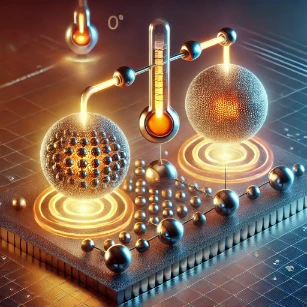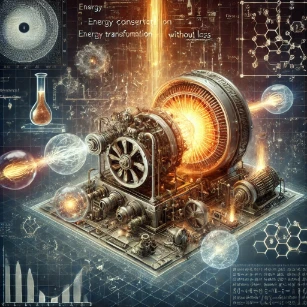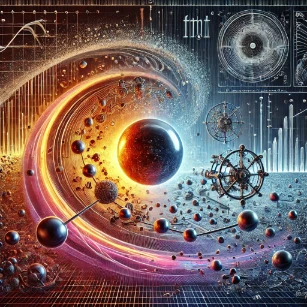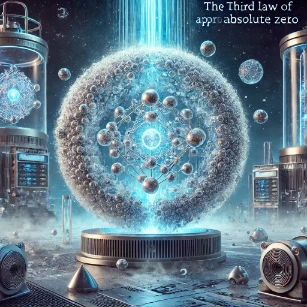Laws of Thermodynamics
The laws of thermodynamics form the foundational principles that govern energy interactions in physical systems. These laws define how energy is conserved, transferred, and transformed, underpinning our understanding of the natural world. Beginning with the zeroth law, which establishes the concept of thermal equilibrium, and extending through the first, second, and third laws, these principles are essential in fields ranging from physics and science to chemical engineering and biological systems. Students often explore these concepts early in their study of thermodynamics, which provides a broader framework for analyzing energy systems.
The first law is a restatement of the conservation of energy, linking internal energy changes with work and heat interactions. It connects naturally with subjects like engineering thermodynamics and thermodynamic cycles, where energy balances are fundamental to designing efficient engines and turbines. The flow of heat, a core element of all thermodynamic systems, is governed by the first and second laws together, ensuring both quantity and direction are considered.
The second law introduces the concept of entropy, which measures the disorder or randomness of a system. It explains why certain processes are irreversible and why energy tends to disperse. This law has significant implications not only in physics but also in areas like physical chemistry and relativity. Its statistical underpinnings link closely to non-equilibrium thermodynamics, where entropy production and gradients play a central role in dynamic systems far from equilibrium.
As technology advances, so does the application of thermodynamic laws. For example, renewable energy systems must comply with these laws while maximizing efficiency, whether in solar panels, geothermal power, or wind turbines. Similarly, innovations in computational thermodynamics allow researchers to model complex interactions and design new materials by applying thermodynamic laws at the atomic level.
These principles extend beyond classical boundaries into modern physics areas such as nuclear fusion, nuclear reactions, and radioactivity. These systems involve enormous energy transfers, and understanding their thermodynamic constraints is vital for reactor safety and energy yield. Thermodynamic laws also provide context for quantum phenomena, from wave function dynamics to wave-particle duality.
Moreover, thermodynamic principles guide phase change analysis, as seen in phase equilibria and transitions, and are essential in predicting the behavior of engineered materials through thermodynamics of materials. Their impact also resonates in related branches such as electrodynamics and plasma physics, where energy interactions shape the behavior of fields and charged particles.
In summary, the laws of thermodynamics serve as a guiding framework for all energy-related phenomena. Whether analyzing engines, molecules, or stars, students and researchers rely on these laws to explain what can happen, what will happen, and what is impossible.
Table of Contents
The Zeroth Law of Thermodynamics establishes the concept of thermal equilibrium and provides the foundation for defining temperature. It states that if two systems are each in thermal equilibrium with a third system, then they must also be in thermal equilibrium with each other. This principle is the basis for temperature measurement using thermometers.

The First Law of Thermodynamics, also known as the Law of Energy Conservation, states that energy cannot be created or destroyed, only transferred or converted from one form to another. This law is essential in understanding the operation of heat engines, electrical power generation, and chemical reactions, as it ensures that total energy within a closed system remains constant.

The Second Law of Thermodynamics introduces the concept of entropy, which quantifies disorder within a system and explains why natural processes tend to move toward equilibrium. This law states that the total entropy of an isolated system always increases over time, making energy transformations inherently inefficient. It explains why heat naturally flows from hot objects to cold ones and why perpetual motion machines are impossible.

The Third Law of Thermodynamics describes the behavior of systems as they approach absolute zero temperature (0 K), stating that the entropy of a perfect crystalline substance becomes zero at absolute zero. This law has implications in low-temperature physics and cryogenics, where achieving absolute zero is theoretically impossible. The Laws of Thermodynamics are foundational to science and engineering, shaping modern technology and deepening our understanding of the universe.

Zeroth Law of Thermodynamics
Statement:
If two systems are each in thermal equilibrium with a third system, then they are in thermal equilibrium with each other.
Implications:
- Introduces the concept of temperature as a measurable property.
- Forms the basis for the construction of thermometers.
Example:
If a cup of tea (System A) and a glass of water (System B) are both in equilibrium with a thermometer (System C), then the tea and water must be at the same temperature.
First Law of Thermodynamics (Law of Energy Conservation)
Statement:
Energy cannot be created or destroyed; it can only be converted from one form to another. The total energy of an isolated system is constant.
Mathematical Form:
Where:
Implications:
- Energy can be transferred as heat or work.
- In any process, the sum of energy transfers equals the change in the system’s internal energy.
Second Law of Thermodynamics
Statement:
In any natural process, the total entropy of a system and its surroundings always increases.
Where:
Entropy measures disorder or randomness.
Implications:
- No process is 100% efficient.
- Heat naturally flows from hot to cold.
- Introduces the concept of irreversibility.
Heat Engine Efficiency:
Where TC and TH are the temperatures of the cold and hot reservoirs.
Third Law of Thermodynamics
Statement:
As the temperature of a perfect crystalline substance approaches absolute zero (0 K), its entropy approaches zero.
Implications:
- It is impossible to reach absolute zero.
- The entropy of a perfect crystal at 0 K is exactly zero.
Why Study Laws of Thermodynamics
Universal Principles Governing Energy and Matter
The laws of thermodynamics describe the fundamental rules governing energy transformation and equilibrium. Students learn how these laws apply to systems in physics, chemistry, and biology. They provide a consistent framework for analyzing any process involving heat, work, or entropy. Understanding these laws is foundational for all scientific and engineering disciplines.
Zeroth and First Laws: Temperature and Energy Conservation
The zeroth law defines thermal equilibrium and allows the use of temperature as a measurable property. The first law expresses conservation of energy, linking heat and work to internal energy. These laws enable students to analyze closed and open systems. They provide tools for quantifying energy changes in processes.
Second Law: Entropy and Directionality
The second law introduces entropy as a measure of disorder and the unidirectional nature of spontaneous processes. Students learn how to evaluate the feasibility of processes and efficiency of heat engines. This law has profound implications in natural and engineered systems. It defines the limits of energy conversion.
Third Law and Absolute Zero
The third law establishes that entropy approaches zero as temperature approaches absolute zero. Students understand how this limits the cooling of systems and sets the groundwork for low-temperature physics. It explains the behavior of specific heats and reaction equilibria at very low temperatures. It refines understanding of entropy and thermal behavior.
Foundation for Multidisciplinary Applications
Mastering thermodynamic laws is essential for applications ranging from climate models to bioenergetics. Students apply these laws in engines, chemical reactions, and information theory. They build versatile tools for theoretical and applied work. They form the intellectual backbone of many technological advancements.
Numerical Examples on Laws of Thermodynamics
Example 1: First Law – Heat and Work
Problem:
A system absorbs 500 J of heat and does 200 J of work. Find the change in internal energy.
Solution:
Answer:
The change in internal energy is 300 J.
Example 2: Isothermal Expansion of an Ideal Gas
Problem:
Calculate the work done when 1 mole of an ideal gas expands isothermally from 2 L to 6 L at 300 K.
Solution:
Answer:
The work done is 2739 J.
Example 3: Carnot Engine Efficiency
Problem:
A heat engine operates between TH = 600K and TC = 300K. Find its maximum efficiency.
Solution:
Answer:
The maximum efficiency is 50%.
Example 4: Entropy Change
Problem:
Calculate the entropy change when 500 J of heat is absorbed by a system at 350 K.
Solution:
Answer:
The entropy change is 1.43 J/K.
Example 5: Energy of an Isobaric Process
Problem:
Calculate the heat absorbed when 2 moles of a gas are heated from 300 K to 500 K at constant pressure. Assume
Solution:
Answer:
The heat absorbed is 11,639.6 J.
Example 6: Work Done in Adiabatic Expansion
Problem:
Find the work done by 1 mole of an ideal gas expanding adiabatically from 5 L to 10 L (ϒ = 1.4)
Solution:
Using the ideal gas law,
Answer:
The work done is 2495 J.
Example 7: Helmholtz Free Energy
Problem:
Calculate the Helmholtz free energy for a system with U = 200J, T = 300K, and S = 0.5J/K.
Solution:
Answer:
The Helmholtz free energy is 50 J.
Example 8: Gibbs Free Energy
Problem:
Determine if a reaction is spontaneous with
Solution:
Convert ΔS to kJ.
Answer:
Since ΔG < 0, the reaction is spontaneous.
Conceptual Questions and Answers on the Laws of Thermodynamics
Question 1:
Why can’t a machine be designed that converts all the heat energy it receives into work without any energy loss?
Answer:
This is prohibited by the Second Law of Thermodynamics, which states that no heat engine can be 100% efficient because some energy must always be lost as waste heat to a colder reservoir. This inherent inefficiency is due to the increase in entropy during energy transformations.
Question 2:
What does the Zeroth Law of Thermodynamics imply about the concept of temperature?
Answer:
The Zeroth Law of Thermodynamics establishes temperature as a measurable and transitive property. It states that if two systems are in thermal equilibrium with a third system, they are also in thermal equilibrium with each other. This principle allows the use of thermometers to measure temperature consistently.
Question 3:
Can a process violate the First Law of Thermodynamics by creating energy?
Answer:
No. The First Law of Thermodynamics states that energy cannot be created or destroyed, only transformed from one form to another. Any claim of a device creating energy (a perpetual motion machine of the first kind) violates this law and is physically impossible.
Question 4:
Why does heat flow naturally from a hot object to a cold one and not the reverse?
Answer:
According to the Second Law of Thermodynamics, heat naturally flows from a higher-temperature object to a lower-temperature one to increase the overall entropy of the system. The reverse process would decrease entropy, which cannot occur spontaneously in a closed system.
Question 5:
What is the significance of entropy in chemical reactions?
Answer:
Entropy (S) measures the randomness or disorder of a system. In chemical reactions, entropy determines the direction of spontaneous processes. A reaction is more likely to occur if it leads to an increase in the total entropy of the system and surroundings, as dictated by the Second Law of Thermodynamics.
Question 6:
Why is it impossible to cool any object to absolute zero?
Answer:
The Third Law of Thermodynamics states that as a system approaches absolute zero, its entropy approaches a minimum value. However, removing the last traces of energy to reach 0 K requires infinite energy and time, making it physically impossible.
Question 7:
How does the First Law of Thermodynamics apply to an isolated system?
Answer:
In an isolated system, there is no exchange of heat or work with the surroundings. Therefore, according to the First Law of Thermodynamics, the internal energy of an isolated system remains constant because neither heat (Q) nor work (W) can cross its boundary.
Question 8:
Why do real engines have efficiencies lower than the ideal Carnot engine?
Answer:
The Carnot engine is an idealized engine that operates with maximum possible efficiency between two temperature reservoirs. Real engines are less efficient due to irreversible processes, friction, heat loss, and other practical limitations that increase entropy, as described by the Second Law of Thermodynamics.
Laws of Thermodynamics: Conclusion
The Laws of Thermodynamics govern how energy is transferred and transformed in natural and engineered systems. From the conservation of energy in the First Law, to the inevitable increase of disorder in the Second Law, and the fundamental limits of reaching absolute zero in the Third Law, these principles are essential for understanding both the natural world and technological processes. Through practical examples, we see how thermodynamics applies to engines, refrigerators, and chemical reactions, highlighting its critical role in science and engineering.
Laws of Thermodynamics: Review Questions and Answers:
1. What is the Zeroth Law of Thermodynamics?
Answer: The Zeroth Law establishes that if two systems are each in thermal equilibrium with a third system, then they are in thermal equilibrium with each other. This law provides the basis for temperature measurement.
2. What does the First Law of Thermodynamics state?
Answer: The First Law, which is the law of energy conservation, states that energy cannot be created or destroyed in an isolated system. It is expressed as ΔU = Q – W, where ΔU is the change in internal energy, Q is the heat added, and W is the work done by the system.
3. How is the Second Law of Thermodynamics related to entropy?
Answer: The Second Law states that in any spontaneous process, the total entropy of an isolated system always increases or remains constant. This law explains the direction of natural processes and the inherent irreversibility of real-world processes.
4. What is the Third Law of Thermodynamics and its significance?
Answer: The Third Law states that as the temperature of a system approaches absolute zero, the entropy of a perfect crystal approaches zero. It provides a reference point for measuring absolute entropy and explains why absolute zero is unattainable.
5. How do the laws of thermodynamics apply to energy conservation in a system?
Answer: The laws collectively explain how energy is conserved and transformed within a system. The First Law ensures energy balance, while the Second and Third Laws describe the limitations imposed by entropy on energy conversion and the efficiency of processes.
6. What is meant by thermodynamic equilibrium?
Answer: Thermodynamic equilibrium is a state where a system’s macroscopic properties (temperature, pressure, and volume) remain constant over time, with no net energy or matter transfer occurring within the system or between it and its surroundings.
7. How does the First Law of Thermodynamics influence engineering system design?
Answer: It guides engineers in designing systems such as engines, refrigerators, and power plants by ensuring that all energy inputs and outputs are accounted for, thereby optimizing energy conversion and minimizing losses.
8. What role does the Second Law play in determining the efficiency of heat engines?
Answer: The Second Law limits the efficiency of heat engines by establishing that some energy will always be lost as waste heat, setting the theoretical maximum efficiency (Carnot efficiency) for any heat engine.
9. Why is the concept of entropy critical in understanding spontaneous processes?
Answer: Entropy quantifies the disorder in a system. An increase in entropy indicates that a process is thermodynamically favorable, as systems naturally evolve toward states with higher disorder and greater numbers of accessible microstates.
10. How do the laws of thermodynamics impact our daily technological applications?
Answer: They underpin the design and operation of devices like air conditioners, engines, and power plants, ensuring energy is used efficiently. Understanding these laws helps optimize performance and develop new technologies that better manage energy and reduce waste.
Laws of Thermodynamics: Thought-Provoking Questions and Answers
1. How might a deeper understanding of thermodynamic laws revolutionize renewable energy systems?
Answer: A refined understanding of energy conversion and entropy could lead to innovative reactor designs and energy recovery systems that maximize efficiency. By minimizing energy losses and optimizing phase transitions, renewable systems like solar thermal and geothermal plants could achieve higher performance and sustainability.
2. What are the philosophical implications of the Second Law regarding the “arrow of time”?
Answer: The Second Law implies that entropy always increases, giving time a preferred direction—from past to future. This challenges the notion of time symmetry found in other physical laws and raises deep philosophical questions about the nature of time and whether the universe is fundamentally irreversible.
3. In what ways can the concept of entropy be applied outside of physics, for example in information theory or economics?
Answer: Entropy in information theory measures uncertainty and information content, paralleling its role in thermodynamics. In economics, it can describe disorder and unpredictability in markets. These cross-disciplinary applications suggest universal principles that govern complex systems, from physical phenomena to social dynamics.
4. How do the thermodynamic limits set by the laws affect the design of future energy-efficient machines?
Answer: The Second Law, in particular, limits the maximum efficiency of energy conversion devices. Recognizing these limits forces engineers to innovate within these constraints, leading to breakthroughs in waste heat recovery, advanced materials, and cycle optimization that push practical devices closer to their theoretical maximum efficiency.
5. What challenges arise when applying the Third Law of Thermodynamics to real-world systems, and how can they be addressed?
Answer: The Third Law implies that absolute zero is unattainable, but in practice, even near-zero temperatures introduce quantum effects and material imperfections. Addressing these challenges involves developing new cooling technologies, high-precision measurement techniques, and models that accurately describe behavior in extreme conditions.
6. How can the integration of computational thermodynamics and experimental data improve industrial process efficiency?
Answer: By combining simulations with real-world data, engineers can better predict system behavior, optimize energy flows, and minimize losses. This integration allows for dynamic adjustments and real-time control, leading to processes that are both more efficient and environmentally sustainable.
7. In what ways might advances in nanothermodynamics lead to revolutionary changes in electronics cooling?
Answer: At the nanoscale, heat transfer mechanisms differ from bulk behavior. Advances in nanothermodynamics could result in the development of materials with superior thermal conductivity or insulative properties, enabling more effective cooling solutions for high-performance electronics and reducing the risk of overheating.
8. How could understanding phase transitions at the microscopic level impact the design of new materials?
Answer: By studying phase transitions, scientists can predict and control material properties such as magnetism, conductivity, and strength. This knowledge can lead to the creation of smart materials that change properties on demand, which has applications in sensors, memory devices, and adaptive structures.
9. What might be the implications of thermodynamic inefficiencies in large-scale power generation on global energy policies?
Answer: Inefficiencies in power generation lead to wasted energy and increased emissions. Understanding and mitigating these inefficiencies can drive policy decisions toward investing in more efficient technologies, renewable energy sources, and sustainable practices, ultimately influencing global energy strategies and reducing environmental impact.
10. How do the laws of thermodynamics help explain the limitations of perpetual motion machines?
Answer: The laws, especially the Second Law, show that some energy will always be lost as heat in any energy conversion process. This inherent loss makes perpetual motion machines impossible, as they would violate the fundamental principles of energy conservation and entropy increase.
11. What role does computational modeling play in predicting and optimizing thermodynamic processes in new industrial technologies?
Answer: Computational modeling allows for the simulation of complex thermodynamic systems, enabling the prediction of phase behavior, energy distribution, and efficiency under various conditions. This capability is crucial for designing cutting-edge industrial processes that are optimized for maximum performance and minimal environmental impact.
12. How might emerging renewable energy technologies benefit from advancements in the study of heat transfer and thermodynamics?
Answer: Improved understanding of heat transfer can lead to the development of more efficient solar collectors, geothermal systems, and thermal storage solutions. By optimizing the capture, conversion, and distribution of energy, renewable energy technologies can become more competitive, reliable, and sustainable in the global energy market.
Numerical Problems and Solutions
1. Calculate the energy (in joules) of a photon with a wavelength of 600 nm using E = hc/λ. (h = 6.626×10⁻³⁴ J·s, c = 3.0×10⁸ m/s)
Solution:
λ = 600 nm = 600×10⁻⁹ m
E = (6.626×10⁻³⁴ J·s × 3.0×10⁸ m/s) / (600×10⁻⁹ m)
≈ (1.9878×10⁻²⁵ J·m) / (600×10⁻⁹ m)
≈ 3.313×10⁻¹⁹ J.
2. A reversible process absorbs 350 J of heat at 300 K. Calculate the change in entropy ΔS.
Solution:
ΔS = Q/T = 350 J / 300 K ≈ 1.167 J/K.
3. For a Carnot engine operating between 800 K and 300 K, determine its maximum efficiency.
Solution:
η = 1 – T_c/T_h = 1 – 300/800 ≈ 1 – 0.375 = 0.625 or 62.5%.
4. Calculate the work done during an isothermal expansion of 1 mole of an ideal gas at 400 K from 1.0 L to 4.0 L. (R = 8.314 J/(mol·K), 1 L = 0.001 m³)
Solution:
W = nRT ln(V_f/V_i)
= 1 × 8.314 × 400 × ln(4.0/1.0)
= 3325.6 × ln(4)
≈ 3325.6 × 1.386
≈ 4606 J.
5. An engine absorbs 1200 J of heat and performs 800 J of work. What is the change in internal energy ΔU?
Solution:
ΔU = Q – W = 1200 J – 800 J = 400 J.
6. For a phase change, if 80 kJ of energy is required to melt 2 kg of a substance, calculate the latent heat of fusion in kJ/kg.
Solution:
Latent heat = Total energy / Mass = 80 kJ / 2 kg = 40 kJ/kg.
7. A reaction has ΔH = -50 kJ/mol and ΔS = -150 J/(mol·K) at 350 K. Calculate the Gibbs free energy change ΔG.
Solution:
ΔG = ΔH – TΔS
= (-50,000 J/mol) – (350 K × -150 J/(mol·K))
= -50,000 + 52,500
= 2,500 J/mol (non-spontaneous if positive).
8. Calculate the equilibrium constant K at 350 K for a reaction with ΔG = -10 kJ/mol. (R = 8.314 J/(mol·K))
Solution:
ΔG = -RT ln K
-10,000 = -8.314×350 ln K
ln K = 10,000 / (8.314×350)
≈ 10,000 / 2909.9 ≈ 3.436
K = e^(3.436) ≈ 31.1.
9. Determine the Helmholtz free energy F for a system with partition function Z = 100 at 300 K. (k_B = 1.38×10⁻²³ J/K)
Solution:
F = –k_BT ln Z
= –1.38×10⁻²³ J/K × 300 K × ln(100)
ln(100) ≈ 4.6052
F ≈ –1.38×10⁻²³ × 300 × 4.6052
≈ –1.908×10⁻²⁰ J.
10. In a simulation, if each iteration takes 5×10⁻⁵ s and 3×10⁶ iterations are required, what is the total simulation time?
Solution:
Total time = 3×10⁶ × 5×10⁻⁵ s = 150 s.
11. Calculate the change in entropy ΔS when 500 J of heat is rejected from a system at 320 K.
Solution:
ΔS = –Q/T = –500 J / 320 K ≈ –1.5625 J/K.
12. A heat exchanger transfers 2000 J of energy between two fluids at 400 K and 300 K. Calculate the entropy change for the entire process (assuming reversible heat transfer).
Solution:
Entropy change for hot fluid: ΔS_hot = -2000 J / 400 K = -5 J/K
Entropy change for cold fluid: ΔS_cold = 2000 J / 300 K ≈ 6.667 J/K
Total ΔS = ΔS_hot + ΔS_cold ≈ -5 + 6.667 = 1.667 J/K.
